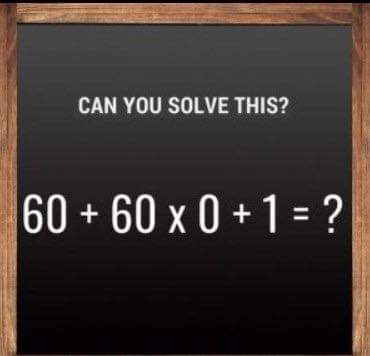Decoding Basic Arithmetic: Understanding Order of Operations

ADVERTISEMENT
Decoding Basic Arithmetic: Understanding Order of Operations
Introduction
Math puzzles and simple arithmetic problems, such as the one displayed in the image, serve as excellent tools to revisit fundamental mathematical principles. These puzzles not only challenge the mind but also highlight the importance of the order of operations in mathematics. This article explores the basic arithmetic operation shown in the image and explains why understanding the order of operations is crucial.
Analysis of the Problem
The problem presented is “60 + 60 x 0 + 1 = ?”. To solve this, we must apply the order of operations, often remembered by the acronym PEMDAS/BODMAS:
- P/B – Parentheses/Brackets
- E/O – Exponents/Orders (i.e., powers and square roots, etc.)
- MD – Multiplication and Division (from left to right)
- AS – Addition and Subtraction (from left to right)
Applying these rules to the problem:
- Multiplication First: Calculate 60 x 0 = 0
- Then Addition: Add the first 60 to the result of the multiplication, which is 0, getting 60 + 0 = 60.
- Finally Addition: Add 1 to the result, yielding 60 + 1 = 61.
Therefore, the correct answer to the problem is 61.
Importance of Order of Operations
The order of operations is vital because it ensures that mathematical expressions are interpreted and solved consistently and correctly. Without a universally accepted order of operations, the same expression could be interpreted in multiple ways, leading to different answers. For example, ignoring the order and performing operations from left to right without regard to the specific rules would give an incorrect result for the given problem.
ADVERTISEMENT
Educational Value
Problems like the one shown are commonly used in educational settings to reinforce the rules of arithmetic and to ensure that students build a strong foundation in mathematical fundamentals. They are also used in various assessment contexts to test students’ understanding and application of these rules.
Conclusion
The simple arithmetic problem presented in the image is more than just a test of one’s ability to calculate; it is a reminder of the structured beauty of mathematics. Understanding and applying the order of operations is essential for anyone studying math, as it is foundational to correctly solving expressions and equations across all levels of complexity.
This article not only solves the presented problem but also underscores the significance of the order of operations, a cornerstone concept in mathematics that facilitates clarity and accuracy in problem-solving.




